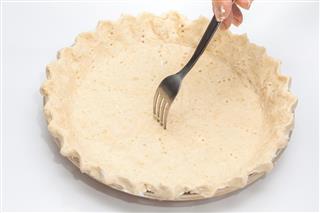
While just the thought of making a pie crust can make some people go cold with fear, there are some simple dos and don’ts that can make all the difference. Once you’ve gotten the hang of making your own quiche crust from scratch, I’ll wager you won’t be going back to the store-bought variety any time soon, not unless you’re seriously pressed for time anyway.
Quiche crusts are most often made from shortcrust pastry, though you can also use flaky pastry, puff pastry, or an enriched shortcrust pastry―for those who are health conscious, substitute oil in place of the shortening for a reduced fat version of the standard quiche recipe. Making pie crust isn’t all that difficult, and the results are well and truly worth the effort.
Basic Recipe
If you’re new to pies and baking, it might help to keep a few points in mind to ensure that your quiche crust is up to the mark. As with all things learned, you will become more proficient as you practice, but to keep disasters to a minimum, the following are some simple tips to getting a perfect pastry.
- Ensure the butter or shortening is chilled―this makes it easier for you to ‘rub in’ the butter; working with room temperature butter, or even butter that is slightly soft will give you a dough of an entirely different consistency.
- Don’t over knead. Just gather the dough together to form a roughly hewn ball, and then refrigerate―this ensures the resultant pastry doesn’t become a chewy disaster.
- Roll in a single direction. This comes with practice―when you roll out the pastry, make sure you work on a clean surface dusted with flour. Often pie crust recipes will instruct you to roll to a given thickness – but a half inch either way is hardly likely to make a difference. The idea is to have the pastry rolled to a uniform thickness, so that cooking is even. Roll from the center outwards, instead of back and forth over the same patch.
- When lining a flan dish, you may have difficulty lifting the rolled pastry without bits falling off because of the weight―a simple solution is to roll the pastry loosely around the rolling pin, and then ‘unroll’ it onto the dish.
Recipe with Butter
Ingredients
- All-purpose flour – 1 cup, plus extra for dusting
- Butter – ½ cup (1 stick), chilled and cut into small cubes
- Salt – ½ tsp
- Iced water – 4 to 5 tsp
Method
- Sift the flour and salt into a clean large bowl. Working with your fingertips, rub the butter into the flour, until it’s all incorporated and the mixture resembles breadcrumbs.
- Sprinkle the iced water onto the mixture, and bring together to form a roughly hewn ball. Don’t knead.
- Place the ball of dough in a lightly oiled plastic bag, and refrigerate for at least 30 minutes.
- When using, pat dough lightly flat onto a floured surface, then roll out using light, but firm strokes.
- Line a pie dish or spring-form tin, and prick all over with a fork.
- Fill and bake as required.
Healthy Recipe
Ingredients
- All-purpose flour – 1 cup, plus extra for dusting
- Olive oil – ¼ cup
- Salt – ½ tsp
- Iced water – 4 to 5 tsp
Method
- Sift together the flour and salt.
- In a separate bowl, whisk the oil and water together, then pour this into the flour, and stir lightly with a fork; bring together to form a ball. Chill.
- Press into a 9-inch spring form pan and dock with a fork.
- Bake as required.
You can use the same amounts for mini quiche crusts, and line a mini tart pan with the rolled out dough―it should serve for 24 miniature quiches. Once you get the hang of these recipes, you’ll find baking them a breeze. With experience, you’ll also know when to incorporate a little more or less flour or butter, to ensure your crust is melt-in-the-mouth crumbly. Make your own signature style quiche crust, by adding cheese, cracked pepper or paprika into the base, and store-bought versions will soon be a thing of the past.

